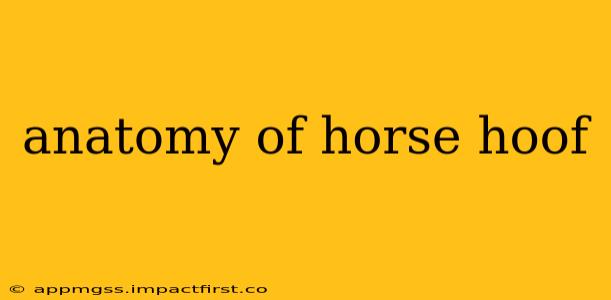The horse's hoof is a marvel of engineering, a complex structure that supports the animal's weight and allows for efficient locomotion. Understanding its anatomy is crucial for anyone involved in equine care, from farriers to veterinarians to passionate horse owners. This comprehensive guide delves into the intricate details of the equine hoof, exploring its various components and their functions.
What are the main parts of a horse's hoof?
The horse's hoof can be broadly divided into several key structures:
-
The Hoof Wall: This is the hard, outer layer of the hoof, providing protection and support. It's comprised of three layers: the stratum externum (outermost layer), stratum medium (middle layer), and stratum internum (innermost layer). The hoof wall grows continuously from the coronary band.
-
The Sole: The sole is the bottom, concave surface of the hoof, protecting the sensitive internal structures. It's composed of tough, keratinized tissue.
-
The Frog: Located in the center of the sole, the frog is a wedge-shaped structure that plays a vital role in shock absorption and blood circulation. It's made of elastic, spongy tissue.
-
The Bars: These are the strong, horny ridges running along the sides of the frog, helping to support the hoof and aid in the expansion and contraction of the hoof during locomotion.
-
The White Line: This is a thin, pale line visible where the sole meets the hoof wall. It represents the junction between the insensitive hoof wall and the sensitive laminae. It's a crucial area and susceptible to infection.
What is the sensitive structure of the horse's hoof?
Beneath the hard outer layers of the hoof lies the sensitive structure, containing vital blood vessels, nerves, and tissues:
-
The Laminar Layer: This is the critical interface between the insensitive hoof wall and the sensitive coffin bone (P3). The interdigitation of the lamellae creates a strong bond, essential for weight-bearing. Damage to the laminae results in laminitis, a painful and potentially debilitating condition.
-
The Coffin Bone (P3): This is the distal phalanx, the last bone of the digit, housed within the hoof capsule. It's crucial for weight bearing.
-
The Navicular Bone: Situated behind the coffin bone, the navicular bone helps to support the deep flexor tendon. Navicular syndrome is a common cause of lameness in horses, often characterized by pain in this area.
-
Digital Cushion: Located beneath the frog and sole, the digital cushion acts as a shock absorber, distributing weight evenly across the hoof.
What is the function of the frog in a horse's hoof?
The frog’s primary function is shock absorption. Its elastic nature helps to dissipate the impact forces experienced during movement, protecting the internal structures of the hoof. Furthermore, the frog plays a vital role in blood circulation within the hoof, acting as a pump to improve blood flow.
How does the horse hoof grow?
The hoof grows continuously from the coronary band, a ring of tissue at the top of the hoof. This growth is analogous to our fingernails, with the rate of growth depending on several factors such as nutrition, blood supply, and overall health.
What are some common hoof problems in horses?
Several factors can affect hoof health. Common problems include:
- Laminitis: Inflammation of the sensitive laminae, a serious condition that can lead to rotation of the coffin bone.
- Abscesses: Infections that can occur anywhere within the hoof.
- Thrush: An infection of the frog.
- Cracks and Chips: These can occur in the hoof wall due to dryness or trauma.
Understanding the anatomy of the horse hoof is paramount for ensuring its health and well-being. Regular hoof care, including trimming and shoeing by a qualified farrier, is essential for maintaining soundness and preventing injury. This complex structure warrants diligent attention to ensure the horse's comfort and performance.
